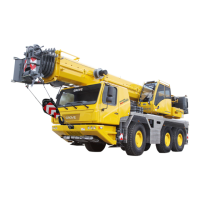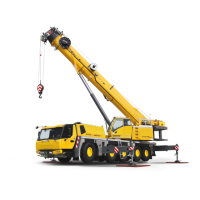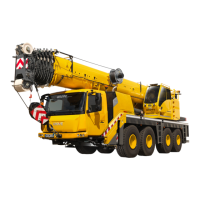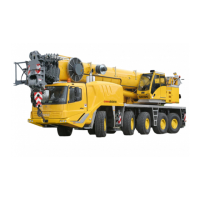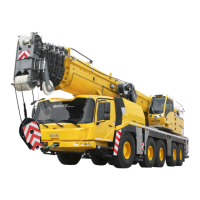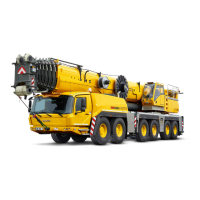Maintenance overview
5.4 Measures required for winch monitoring
5 - 24 3 302 649 en Maintenance manual
GMK4090
07.12.2017
One of the load spectrums listed above should be selected on the basis of
the actual operating conditions and entered in the crane logbook for the
respective testing interval.
Note for truck cranes:
The load spectrum L1 and the factor of the load spectrum Km = 0.125 are
generally applied to truck cranes in assembly mode.
Determining the
effective operat-
ing hours T
i
The effective operating hours of the winches need to be entered in the crane
logbook for the respective inspection interval.
– The effective winch operating hours T
i
displayed in the Operating hours
menu
; à Operating manual.
Determining the
proportion of the-
oretical service
life used
For an inspection interval i (max. 1 year according to ISO 9927-1) or BGV D 6
(VBG 9) / BGV D 8 (VBG 8), the proportion of theoretical service life used S
i
is
calculated using the formula:
This used proportion is subtracted from the remaining theoretical service
life D
i
after every inspection interval (see example in the appendix to this
chapter).
If the remaining theoretical service life is not sufficient for the next operating
period, then a general overhaul of the winch must be performed.
If theoretical service life D has been reached (à Theoretical service life,
p. 5 - 21), the winch must not be operated until after a general overhaul
has been performed.
A general overhaul must always be performed at least once every 10 years
after putting the truck crane into operation.
Km = Factor of the load spectrum used as the basis for winch calculation.
This factor is given in the operating manual.
Km
i
= Factor of the load spectrum in inspection interval i in accordance
with the section “Determining the operating conditions (load
spectrum)”
T
i
= Effective operating hours in the testing interval i as described in
the section “Determining the actual operating hours T
i
”
